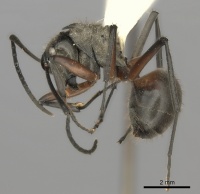Polyrhachis rufofemorata
| Polyrhachis rufofemorata | |
|---|---|

| |
| Scientific classification | |
| Kingdom: | Animalia |
| Phylum: | Arthropoda |
| Class: | Insecta |
| Order: | Hymenoptera |
| Family: | Formicidae |
| Subfamily: | Formicinae |
| Tribe: | Camponotini |
| Genus: | Polyrhachis |
| Subgenus: | Myrma |
| Species: | P. rufofemorata |
| Binomial name | |
| Polyrhachis rufofemorata Smith, F., 1859 | |
| Subspecies | |
| |
| Synonyms | |
| |
Polyrhachis rufofemorata is lignicolous, selecting various plant cavities for its nesting sites, with most colonies found occupying hollow internodes of standing dead bamboo.
Identification
A member of the Polyrhachis relucens species group.
As indicated by Kohout (1989, 1998), P. rufofemorata appears in two distinct forms that differ primarily in the development of the petiolar node. In the nominal form, including most of its synonyms (P. merops Fr. Smith, 1860, P. biroi Forel, 1907 and P. biroi paprika Forel, 1911), the petiole is simply angulate or at most minutely dentate, while it is clearly spinose in P. biroi bidentata. Both forms are relatively common throughout New Guinea and are occasionally sympatric. However, it appears that Indonesian populations of P. rufofemorata include only the nominal form, while Australian populations are characterised by the distinctly spinose petiole. Queens of both forms are very similar with only a little variability demonstrated between various populations.
Keys including this Species
Distribution
The known distribution of P. rufofemorata extends from the Moluccas and New Guinea to northern Australia, where it occurs at Iron Range on Cape York Peninsula (Kohout, 2012).
Latitudinal Distribution Pattern
Latitudinal Range: -0.616667° to -12.73888889°.
| North Temperate |
North Subtropical |
Tropical | South Subtropical |
South Temperate |
- Source: AntMaps
Distribution based on Regional Taxon Lists
Australasian Region: Australia.
Indo-Australian Region: Indonesia (type locality), New Guinea.
Distribution based on AntMaps
Distribution based on AntWeb specimens
Check data from AntWeb
Countries Occupied
| Number of countries occupied by this species based on AntWiki Regional Taxon Lists. In general, fewer countries occupied indicates a narrower range, while more countries indicates a more widespread species. |

|
Estimated Abundance
| Relative abundance based on number of AntMaps records per species (this species within the purple bar). Fewer records (to the left) indicates a less abundant/encountered species while more records (to the right) indicates more abundant/encountered species. |

|
Biology
Association with Other Organisms
 Explore: Show all Associate data or Search these data. See also a list of all data tables or learn how data is managed.
Explore: Show all Associate data or Search these data. See also a list of all data tables or learn how data is managed.
- This species is a host for the fungus Ophiocordyceps unilateralis (a parasitoid) (Quevillon, 2018) (encounter mode primary; direct transmission; transmission outside nest).
- This species is a host for the fungus Ophiocordyceps unilateralis (a pathogen) (Shrestha et al., 2017).
Castes
Males and immature stages are present in the ANlC and RJK spirit collections.
Worker
Images from AntWeb
 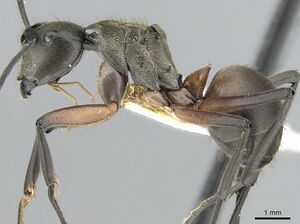 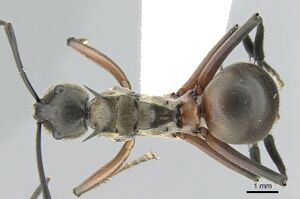 
| |
| Worker. Specimen code casent0281389. Photographer Estella Ortega, uploaded by California Academy of Sciences. | Owned by PSWC, Philip S. Ward Collection. |
    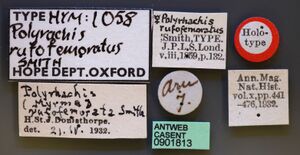
| |
| Holotype of Polyrhachis rufofemorata. Worker. Specimen code casent0901813. Photographer Will Ericson, uploaded by California Academy of Sciences. | Owned by OUM, Oxford, UK. |
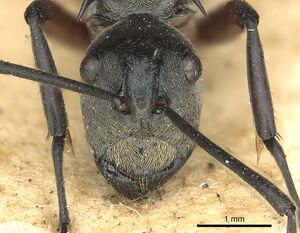   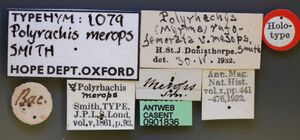
| |
| Holotype of Polyrhachis merops. Worker. Specimen code casent0901836. Photographer Ryan Perry, uploaded by California Academy of Sciences. | Owned by OUM, Oxford, UK. |
Nomenclature
The following information is derived from Barry Bolton's Online Catalogue of the Ants of the World.
- rufofemorata. Polyrhachis rufofemoratus Smith, F. 1859a: 142 (w.) INDONESIA (Aru I.). Kohout, 1989: 514 (w.q.). Combination in P. (Myrma): Emery, 1925b: 202. Senior synonym of merops: Bolton, 1974b: 178; of bidentata, biroi, paprika: Kohout, 1998: 523. Current subspecies: nominal plus atra.
- merops. Polyrhachis merops Smith, F. 1860b: 98, pl. 1, fig. 17 (w.) INDONESIA (Batjan I.). Combination in P. (Myrma): Emery, 1925b: 202. Subspecies of rufofemorata: Emery, 1898a: 228; Donisthorpe, 1932c: 460. Junior synonym of rufofemorata: Bolton, 1974b: 178.
- biroi. Polyrhachis biroi Forel, 1907a: 40 (w.) INDONESIA (Ambon I.). Combination in P. (Myrma): Emery, 1925b: 200. Junior synonym of rufofemorata: Kohout, 1998: 523.
- paprika. Polyrhachis biroi var. paprika Forel, 1911e: 296 (w.) NEW GUINEA. Combination in P. (Myrma): Emery, 1925b: 200. Junior synonym of rufofemorata: Kohout, 1998: 523.
- bidentata. Polyrhachis biroi var. bidentata Stitz, 1912: 512 (w.) NEW GUINEA. Combination in P. (Myrma): Emery, 1925b: 200. Junior synonym of rufofemorata: Kohout, 1998: 523.
Unless otherwise noted the text for the remainder of this section is reported from the publication that includes the original description.
Description
Worker
Kohout (1989) - Dimensions: TL 8.47-9.58; HL 2.27-2.53; HW 1.62-1.84; CI 71-77; SL 2.71-3.02; SI 154-170; PW 1.03-1.31; MTL 3.02-3.48 (35 measured).
Mandibles with 5 teeth. Clypeus sinuate in profile, convex above, concave below; median carina more or less distinct; anterior margin truncated medially. Sides of head in front of eyes only feebly convex (almost straight in some specimens), slightly converging anteriorly; behind the eyes broadly convex. Eyes convex, in full face view not or only marginally breaking the outline of the head. Median ocellus weakly marked in some specimens. Frontal carinae sinuate with sharply raised lobes. Pronotum with a pair of long, divergent, somewhat flattened spines; their outer borders continuous, with posteriorly diverging lateral margins. Mesonotal dorsum wider than pronotum at the base, transversely convex, lateral margins acute but not laminate. Propodeal dorsum deeply concave between lateral margins, which form almost vertically raised lamellate flanges; posterior angles rounded, not acute. Petiole scale-like. with dorsal edge usually angulate or dentate, but also distinctly spinose, as in some New Guinean and all known Australian populations. Base of first gastral tergite very shallowly concave.
Mandibles finely longitudinally striate, with numerous piliferous pits. Anterior c1ypeal margin medially with a row of distinct pits from which long hairs arise. Sculpturation of the head and mesosoma consisting of fine to coarse reticulations, with dorsum of the head more or less longitudinally striate. Intensity of the sculpturation decreasing posteriorly, the petiole and gaster finely shagreened.
Short to medium long, semierect, yellow to rusty-brown hairs scattered all over the body. Short appressed pubescence of variable density everywhere, but almost absent from the petiole and the base of the first gastral tergite; colour of the pubescence yellow with distinct reddish tint on dorsum of head, -mesosoma and gaster, more silvery on lateral and ventral surfaces of the body and appendages.
Body distinctly bicoloured; black, with the petiole, base of the first gastral tergite, coxae and femora, save for their apical portions, light to medium reddish-brown. Tips of the petiolar spines or dentic1es also black.
Queen
Kohout (1989) - Dimensions: TL 9.42-10.43; HL 2.37-2.59; HW 1.68-1.89; CI 70-75; SL 2.77-3.02; SI 154-168; PW 1.61-1.91; MTL 3.17-3.53 (14 measured).
Female larger, with the usual characters identifying full sexuality. The sculpturation, pubescence and coloration is similar to that of the worker. Eyes convex, usually breaking the outline of the head. Configuration of the petiolar spines cute teeth, situated along the dorsal edge of the segment between the distinct lateral angles.
Type Material
Kohout (2008) - Holotype worker. Type locality: INDONESIA, Aru Is (A. R. Wallace), Oxford University Museum of Natural History (examined).
Polyrhachis rufofemoratus type material.
Holotype worker from Aru Island, Indonesia (A.R. Wallace) (Oxford University Museum of Natural History) (examined by Kohout, 2012).
Polyrhachis biroi bidentata type material.
Syntype workers from Sattelberg, New Guinea (Lauterbach) (Berlin Museum für Naturkunde der Humboldt-Universität) (examined by Kohout, 2012).
- Holotype, worker, Aru Island, Indonesia, Oxford University Museum of Natural History.
The following notes on F. Smith type specimens have been provided by Barry Bolton (details):
Polyrhachis merops
Holotype worker in Oxford University Museum of Natural History. Labelled “Bac.” (= Batjan I.) and with a Donisthorpe type-label.
Polyrhachis rufofemoratus
Holotype worker in Oxford University Museum of Natural History. Labelled “Aru 7” (= Aru I., New Guinea) and with a Donisthorpe type-label.
Additional specimens are present in Oxford University Museum of Natural History, from “Ceram” (= Seram I.), “Wag.” (= Waigeo I.) and “Gor.” (=?).
References
- Bolton, B. 1974b [1973]. New synonymy and a new name in the ant genus Polyrhachis F. Smith (Hym., Formicidae). Entomol. Mon. Mag. 109: 172-180 (page 178, Senior synonym of merops)
- Emery, C. 1925d. Hymenoptera. Fam. Formicidae. Subfam. Formicinae. Genera Insectorum 183: 1-302 (page 202, Combination in P. (Myrma))
- Kohout, R. J. 1989. The Australian ants of the Polyrhachis relucens species-group (Hymenoptera: Formicidae: Formicinae). Mem. Qld. Mus. 27: 509-516 (page 514, worker, queen described)
- Kohout, R. J. 1998. New synonyms and nomenclatural changes in the ant genus Polyrhachis Fr. Smith (Hymenoptera: Formicidae: Formicinae). Mem. Qld. Mus. 42: 505-531 (page 523, Senior synonym of bidentata, biroi, and paprika)
- Kohout, R.J. 2008a. A review of the Polyrhachis ants of Sulawesi with keys and descriptions of new species (Hymenoptera: Formicidae: Formicinae). Memoirs of the Queensland Museum. 52:255-317.
- Kohout, R.J. 2012. A review of the Australian Polyrhachis ants of the subgenera Myrma Billberg, Myrmatopa Forel, Myrmothrinax Forel and Polyrhachis Fr. Smith (Hymenoptera: Formicidae: Formicinae). Memoirs of the Queensland Museum – Nature 56(1): 25-59.
- Latumahina, F., Borovanska, M., Musyafa, Sumardi, Susetya Putra, N., Janda, M. 2015. Ants of Ambon Island – diversity survey and checklist. ZooKeys 472, 43–57 (doi:10.3897/zookeys.472.8441).
- Shrestha B, Tanaka E, Hyun MW, Han JG, Kim CS, Jo JW, Han SK, Oh J, Sung JM, Sung GH. 2017. Mycosphere Essay 19. Cordyceps species parasitizing hymenopteran and hemipteran insects. Mycosphere 8(9): 1424–1442 (DOI 10.5943/mycosphere/8/9/8).
- Smith, F. 1859a. Catalogue of hymenopterous insects collected by Mr. A. R. Wallace at the islands of Aru and Key. [part]. J. Proc. Linn. Soc. Lond. Zool. 3: 132-158 (page 142, worker described)
References based on Global Ant Biodiversity Informatics
- Bolton B. 1974. New synonymy and a new name in the ant genus Polyrhachis F. Smith (Hym., Formicidae). Entomol. Mon. Mag. 109: 172-180
- Chapman, J. W., and Capco, S. R. 1951. Check list of the ants (Hymenoptera: Formicidae) of Asia. Monogr. Inst. Sci. Technol. Manila 1: 1-327
- Donisthorpe H. 1947. Ants from New Guinea, including new species and a new genus. Annals and Magazine of Natural History (11)13: 577-595.
- Donisthorpe, Horace. 1943. The Ants of Waigeu Island, North Dutch New Guinea. The Annals and Magazine of Natural History 11 (10): 433-475.
- Emery C. 1886. Saggio di un catalogo sistematico dei generi Camponotus, Polyrhachis e affini. Memorie della Reale Accademia delle Scienze dell'Istituto di Bologna 5: 363-382
- Emery C. 1887. Catalogo delle formiche esistenti nelle collezioni del Museo Civico di Genova. Parte terza. Formiche della regione Indo-Malese e dell'Australia. [part]. Ann. Mus. Civ. Stor. Nat. 24(4): 209-258.
- Emery C. 1898. Descrizioni di formiche nuove malesi e australiane. Note sinonimiche. Rendiconti delle Sessioni della Reale Accademia delle Scienze dell'Istituto di Bologna (n.s.)2: 231-245.
- Emery C. 1901. Formiciden von Celebes. Zoologische Jahrbücher. Abteilung für Systematik, Geographie und Biologie der Tiere 14:565-580.
- Emery C. 1911. Formicidae. Résultats de l'expédition scientifique néerlandaise à la Nouvelle-Guinée en 1903 sous les auspices de Arthur Wichmann. Nova Guinea 5: 531-539.
- Emery, C. "Catalogo delle formiche esistenti nelle collezioni del Museo Civico di Genova. Parte terza. Formiche della regione Indo-Malese e dell'Australia." Annali del Museo Civico di Storia Naturale Giacomo Doria (Genova) (2) 4, no. 24 (1887): 209-258.
- Forel A. 1907. Formicides du Musée National Hongrois. Ann. Hist.-Nat. Mus. Natl. Hung. 5: 1-42.
- Forel A. 1911. Die Ameisen des K. Zoologischen Museums in München. Sitzungsber. Math.-Phys. Kl. K. Bayer. Akad. Wiss. Münch. 11: 249-303.
- Janda M., G. D. Alpert, M. L. Borowiec, E. P. Economo, P. Klimes, E. Sarnat, and S. O. Shattuck. 2011. Cheklist of ants described and recorded from New Guinea and associated islands. Available on http://www.newguineants.org/. Accessed on 24th Feb. 2011.
- Klimes P., P. Fibich, C. Idigel, and M. Rimandai. 2015. Disentangling the diversity of arboreal ant communities in tropical forest trees. PLoS ONE 10(2): e0117853. doi:10.1371/journal.pone.0117853
- Kohout R. J. 1989. The Australian ants of the Polyrhachis relucens species-group (Hymenoptera: Formicidae: Formicinae). Memoirs of the Queensland Museum 27: 509-516
- Kohout R. J. 1998. New synonyms and nomenclatural changes in the ant genus Polyrhachis Fr. Smith (Hymenoptera: Formicidae: Formicinae). Memoirs of the Queensland Museum 42: 505-531
- Kohout R. J. 2012. A review of the Australian Polyrhachis ants of the subgenera Myrma Billberg, Myrmatopa Forel, Myrmothrinax Forel and Polyrhachis Fr. Smith (Hymenoptera: Formicidae: Formicinae). Memoirs of the Queensland Museum 56(1): 25-59.
- Kohout, R. J. 2008. A review of the Polyrhachis ants of Sulawesi with keys and descriptions of new species (Hymenoptera: Formicidae: Formicinae). Memoirs of the Queensland Museum 52:255-317.
- Latumahina F., M. Borovanska, N. S. Putra, and M. Janda. 2015. Ants of Ambon Island diversity survey and checklist. ZooKeys 472: 4357.
- Lucky A., E. Sarnat, and L. Alonso. 2011. Ants of the Muller Range, Papua New Guinea, Chapter 10. In Richards, S. J. and Gamui, B. G. (editors). 2013. Rapid Biological Assessments of the Nakanai Mountains and the upper Strickland Basin: surveying the biodiversity of Papua New Guineas sublime karst environments. RAP Bulletin of Biological Assessment 60. Conservation International. Arlington, VA.
- Robson Simon Ant Collection, 05-Sept-2014
- Robson Simon Database Polyrhachis -05 Sept 2014
- Smith F. 1861. Catalogue of hymenopterous insects collected by Mr. A. R. Wallace in the islands of Ceram, Celebes, Ternate, and Gilolo. [part]. Journal and Proceedings of the Linnean Society of London. Zoology 6: 36-48.
- Smith F. 1863. Catalogue of hymenopterous insects collected by Mr. A. R. Wallace in the islands of Mysol, Ceram, Waigiou, Bouru and Timor. Journal and Proceedings of the Linnean Society of London. Zoology 7: 6-48.
- Smith, Fr. "Catalogue of hymenopterous insects collected by Mr. A. R. Wallace in the Islands of Bachian, Kaisaa, Amboyna, Gilolo, and at Dory in New Guinea." Journal of the Proceedings of the Linnean Society of London, Zoology 5 (1860): 93-143.
- Snelling R. R. 1998. Insect Part 1: The social Hymenoptera. In Mack A. L. (Ed.) A Biological Assessment of the Lakekamu Basin, Papua New Guinea, RAP 9. 189 ppages
- Snelling R. R. 2000. Ants of the Wapoga river area, Irian Jaya, Indonesia. In Mack, Andrew L. and Leeanne E. Alonso (eds.). 2000. A Biological Assessment of the Wapoga River Area of Northwestern Irian Jaya, Indonesia. RAP Bulletin of Biological Assessment 14, Conservation International, Washington, DC.
- Stitz H. 1911. Australische Ameisen. (Neu-Guinea und Salomons-Inseln, Festland, Neu-Seeland). Sitzungsberichte der Gesellschaft Naturforschender Freunde zu Berlin 1911: 351-381.
- Stitz H. 1912. Ameisen aus Ceram und Neu-Guinea. Sitzungsberichte der Gesellschaft Naturforschender Freunde zu Berlin 1912: 498-514.
- Viehmeyer H. 1912. Ameisen aus Deutsch Neuguinea gesammelt von Dr. O. Schlaginhaufen. Nebst einem Verzeichnisse der papuanischen Arten. Abhandlungen und Berichte des Königlichen Zoologischen und Anthropologische-Ethnographischen Museums zu Dresden 14: 1-26.
- Viehmeyer H. 1914. Papuanische Ameisen. Deutsche Entomologische Zeitschrift 1914: 515-535.
